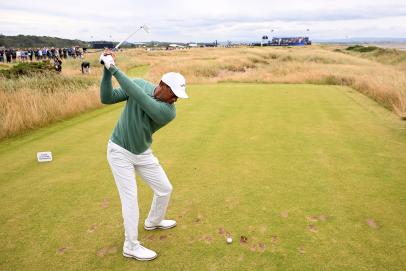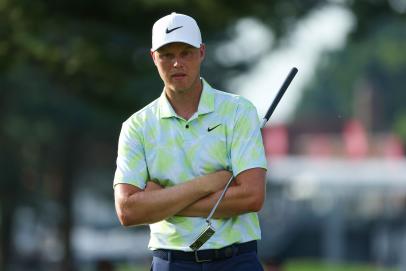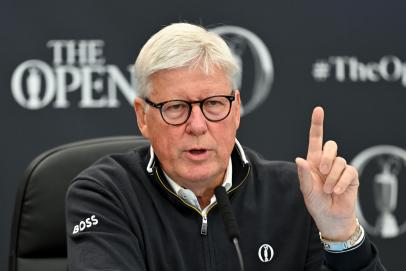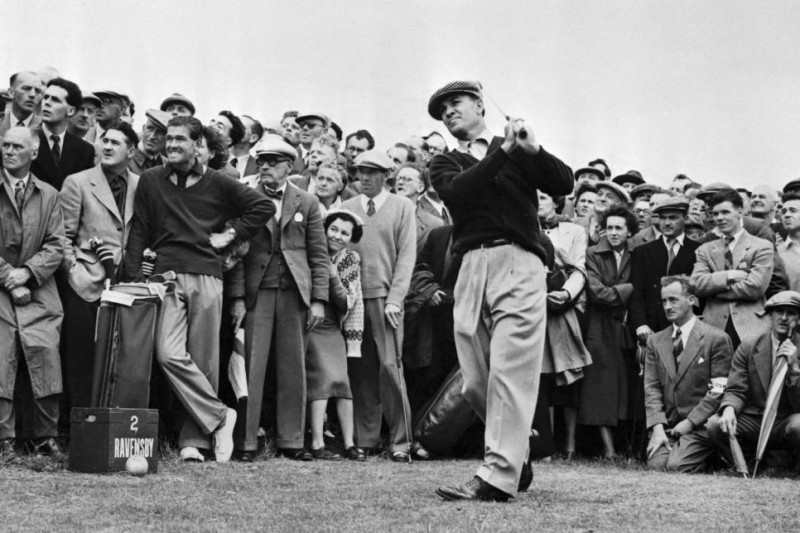TROON, Scotland — In the fall of 1963, four years into his time in America, Gordon Murray was giving a lesson to a woman named Janet Lee Auchincloss at Maryland’s Chevy Chase Country Club. She had brought her granddaughter Caroline, just 5 years old, and the girl played behind them. In the middle of the lesson, the starter came out with an urgent message—Aucinchloss was needed on the phone. Murray drove them back to the clubhouse, and when she picked up the receiver, the voice on the other end told her that her son-in-law, John F. Kennedy, had been shot in Dallas.
• • •
Gordon Murray is 88 years old now, and he lives in a beautiful flat on Portland Terrace in Troon overlooking the Firth of Clyde. Walk 20 minutes southeast, past the beach and the great white ferris wheel, past the fields of fescue and ragwort and yarrow, and you'll run into Royal Troon Golf Club, host of this year's British Open. For an hour on Wednesday afternoon, with the sun shining over the water, Murray chatted about his life and golf looking out his large bay window that offered "the best view in Troon." He gave an entertaining and occasionally staggering account of his 88 years, but you had a feeling we only scratched the surface; his afternoon with JFK's mother-in-law and daughter on the day the president was killed is just one example of a life that has an almost Zelig-like quality—through golf, he has been in some very interesting places at some very interesting times.
And some very interesting things just seem to happen around him. This is a man who, as he's showing you his photos can casually point to a image of his son—long-haired and youthful in the picture—and tell you that he's Bruce Murray, who retired from a professional soccer career as the leading score in the history of the U.S. Men's National Team. It's almost unbelievable, but from Murray's humble demeanor, you know that embellishments are furthest from his mind.
In his career as a PGA teaching pro, first at Gleneagles and then in the U.S. at Burning Tree, Chevy Chase and Bretton Woods, Murray has had occasion to play with a jaw-dropping cast of the famous and powerful. Names as diverse as King Badouin of Belgium and Jesse Owens pass from his lips with ease. Bing Crosby, side by side with Bob Hope, serenaded his wife Elro at Gleneagles with "Oh What a Beautiful Mornin.'" Prime Minister Harold Macmillan and his wife Lady Dorothy were old-fashioned, and wore Grenfell clothing. Rita Hayworth left her latest husband in the clubhouse at Chevy Chase while she and Murray played together, and he remembers that she was "a terrible swearer." He played at Gleneagles with Douglas Bader, the World War II British flying ace, when Bader shot a 72 despite having lost both his legs in a crash. When he played with King Edward VIII at Chevy Chase, it was after the monarch abdicated due to his controversial marriage with Wallis Simpson, and Murray had the nerve to ask him what he carried in the flask on his bag.
"Darjeeling tea, sir," the former king replied. "Darjeeling tea."
More from Golf Digest
 Voices
British Open 2024: Tiger Woods fired back at Colin Montgomerie, but Monty knows the truth
Voices
British Open 2024: Tiger Woods fired back at Colin Montgomerie, but Monty knows the truth
 Numbers game
British Open 2024: Cam Davis is an angry alternate
Numbers game
British Open 2024: Cam Davis is an angry alternate
 british open
British Open 2024: Head of R&A expresses worry about pro golf's money increases
british open
British Open 2024: Head of R&A expresses worry about pro golf's money increases
Add to this a list of Washington D.C.'s power brokers, including four U.S. Presidents. George H.W. Bush was a nice man, and a good stick. Richard Nixon, upon meeting him at Chevy Chase, asked if he was from the south. "Yes sir," Murray replied. "The south of Scotland." JFK was another strong golfer, and when they played at Chevy Chase, in a sort of harbinger of what Murray would experience later, the Secret Service intervened after the fifth hole to re-route their group, and they finished by playing 16, 17, and 18—he was never told why. Then there was Dwight Eisenhower, who would fly in with two helicopters.
"Eisenhower was one of the worst golfers I've ever seen."
• • •
Murray was born in St. Andrews and took up golf at age 12. At first, he started playing in the fields by a local castle, using the clubs from the rack of a gamekeeper to hit balls at the trunk of trees. He was hooked quickly, and when Ben Hogan came to the British Open for the first and only time in his career, in 1953, he made the trip to Carnoustie to see the great player. That was the year Hogan won three majors, and he made the trip early to Scotland to practice obsessively (the standard British ball at the time was smaller) in what he understood would almost certainly be only chance to win the tournament. On Friday, July 10, when the final two rounds of the tournament were held, Murray followed Hogan for 36 holes. He still vividly remembers Hogan missing the fifth green—one of just two he missed on the day—and taking so much time evaluating his downhill 60-yard chip that the fans began to grow restless. Hogan was facing a downhill shot over a bunker, a cigarette hanging from his mouth as he walked back and forth to the hole on the tiered green twice. Then he took the pin out and buried the chip.
When Hogan won, it took him an hour to come collect the trophy. Murray was still watching when he walked in wearing a brown polo-neck sweater and received an ovation from the Carnoustie Club. Hogan took the trophy and never said a word, recalls Murray, even to acknowledge the grounds crew or the course.
"He just took the trophy and left," Murray said, still stunned these 70 years later. "He was a peculiar guy."

Among Murray's favorite golf memories is following Ben Hogan for the final 36 holes at Carnoustie en route to his 1953 British Open win.
Bettmann
Murray won 22 trophies in his two-year amateur career in Scotland, went on to serve in the Royal Air Force, and then got the job as an assistant to Jock McLean at Gleneagles. There, he met Coleman Jennings, a philanthropist and member at Chevy Chase Club, and through him, he got the job at Burning Tree and Chevy Chase soon after, at age 22. (Before he arrived in the U.S., he took one crack at qualifying for the Open, but didn't make the cut.) He stayed at Chevy Chase for eight years, and then moved to Bretton Woods, a new D.C. course being developed on the Potomac River by the International Monetary Fund at the behest of James Symington, Chief of Protocol of the U.S. The concept was to create a venue where minorities could play, although according to Murray, that original purpose never came to pass. He helped design the course and served as head professional until 1988. When he retired, he decided to start his own business conducting golf tours in Scotland. He built it from the ground and quickly grew to serving 250 people per year. He moved back to Scotland, and today the business is mostly run by his sons, though at 88 Murray still serves special clients.
Part of the reason the memory of the '53 Open is so vivid for Murray is Ben Hogan himself, of course, but part of it is Carnoustie, which he considers the finest course in Scotland. "If you played Carnoustie, you'd remember every hole you played because it's so good," he said. "That's the sign of a good golf course.
He thinks highly of Troon, too, except for the first three holes, which he called "no good."
And what about St. Andrews?
"People here call it the cow pasture," he said, with a slight grin.
He doesn't like that there are no bunkers on the first or 18th hole at the Old Course, and while he conceded that the 17th is a nice hole, he called the ninth and 10th "drive and pitch holes." But in his time running his business, he knows how important St. Andrews is to people who love golf, and he took pride in being present with his clients to ensure they got on the popular course—a perk of the connections he's amassed over 88 years.
"Every person who has been with me has played St. Andrews," he said. "That's a record. Not many people can do that one."
As we left his flat, his wife Elro gave me a chocolate bar, and he walked me through a series of posters and photographs leading down the staircase to the bottom floor. The flat overlooking the beach was a kind of encyclopedia of golf history, but you felt as you left the building that it couldn't come close to matching the repository in the mind of its host.
• • •
Is it the British Open or the Open Championship? The name of the final men’s major of the golf season is a subject of continued discussion. The event’s official name, as explained in this op-ed by former R&A chairman Ian Pattinson, is the Open Championship. But since many United States golf fans continue to refer to it as the British Open, and search news around the event accordingly, Golf Digest continues to utilize both names in its coverage.
• • •
MORE GOLF DIGEST BRITISH OPEN COVERAGE
British Open 101: Answering all your frequently asked questions
How to watch the British Open on TV and streaming
Tee times for Rounds 1 and 2 at Troon
Power Rankings: Every player in the field at Royal Troon
Video: Every hole at Royal Troon
How hard can the 123-yard Postage Stamp hole really be? Our deep-dive explantion
Tiger Woods and when enough is enough
History of the claret jug: 152 years of triumphs, dents and lots of drinking
How Brian Harman (aka ‘The butcher of Hoylake’) beat the British tabloids
Rory McIlroy’s media blowoff reignites debate about obligation in the face of frustration
Links golf interactive: What shots you should play on a links course